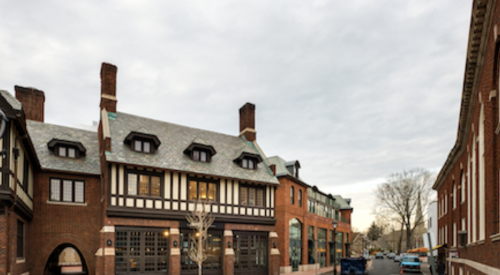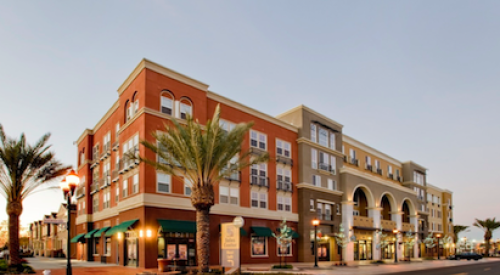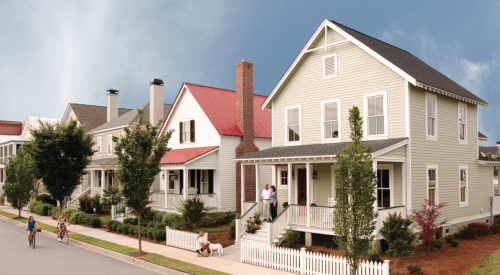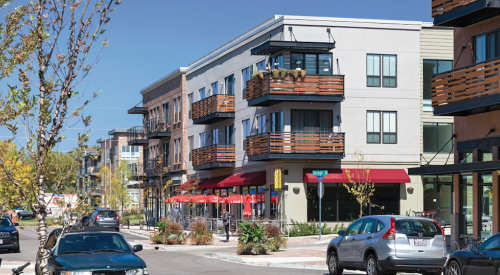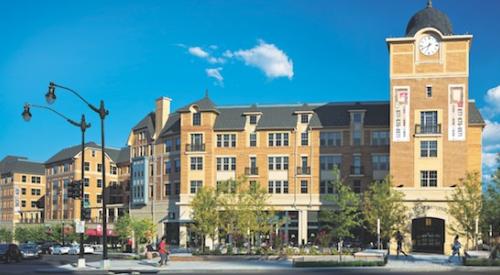|
 |
 |
| Residential communities around light rail include Vallagio at Inverness (top), which is south of Denver, and Del Mar Station (bottom) in Pasadena. |
But too many builders believe success comes easily in rail hubs; a builders playing field is different than typical projects in its portfolio. Success, say urban planning experts, city officials and building industry leaders, involves being able to navigate a complex framework of competing interests. That includes everything from financing strategies to zoning ordinances that dictate affordability, density requirements, architectural style and materials.
"Developments around transit lines are harder to design, entitle, finance and build than any other kind due to the sheer variety of elements that are part of their makeup, function and execution. However, because they can be a valuable asset to their community as a new identity and activity center, they also offer the potential for high economic return on investment," says Marilee Utter, president of Denver-based Citiventure Associates. The private consulting firm works with municipalities and developers nationwide as they forge into the relatively new territory of transit-oriented and transit-adjacent development.
"Transit-oriented development is really an effort to recapture the sense of community-type lifestyle that once characterized our inner cities," she says.
Urban areas are re-emerging as popular places to live and work. Over the past century, the percentage of urban residents in the U.S. doubled from 40 percent to 80 percent. Between 2000 and 2005, eight of the country's 10 largest cities experienced an increase in population based on data complied by the U.S. Census Bureau. City centers and new transit "villages" offer an appealing alternative to life in the suburbs, particularly for affluent singles and empty nesters who embrace a lock-and-leave lifestyle or who want to live close to work. Centers and new transit "villages" offer an appealing alternative to life in the suburbs, particularly for affluent singles and empty nesters who embrace a lock-and-leave lifestyle or who want to live close to work.
Residents in transit-oriented development (TOD) communities benefit from a better quality of life through reduced commute times, lower transportation costs, lower dependence on cars, reduced environmental impact, less traffic congestion and more affordable housing.
"Developers and builders are like any American company. They identify a market inefficiency or need and work to fill it," says Art Lomenick, managing director of Dallas-based Trammell Crow Residential and High Street Residential, who is a highly respected authority on pedestrian-oriented neighborhood design. "These include underdeveloped areas [and] tired or worn parts of town or suburbs that want their own downtown."
One of today's most popular and environmentally friendly transit options is light rail, where electrically-powered train cars travel along a fixed-rail system that connects a city's downtown with its surrounding shopping, entertainment and employment centers.
Here are 10 tips for builders looking to enter the rail arena.
- Develop a strong public/private partnership.
The complicated and often lengthy public rezoning and review process required to lay the foundation for residential projects in mixed-use communities near rail stations can discourage developers from seeking these kinds of projects.
"I get the sense that many developers that I talk to these days are angry about the difficulty of building around light rail," says Gloria Ohland, vice president of communications for Reconnecting America, a national non-profit organization dedicated to the integration of transportation systems within communities they serve.
The ideal solution is a cooperative relationship between the public and private sector that recognizes the benefits for both. "In almost every case, successful transit-oriented development is dependant on a solid public/private partnership," says Utter.
The decision-making process is different for the public and private sectors because the economics for each is different, Lomenick says. "Private developers are really looking at a 3- to 5-year investment, while the city's timeline goes on and on."
"Coordination, cooperation and collaboration are essential in a good public/private partnership," says Harold Stitt, community development manager for the city of Englewood, which is located along the Southwest corridor of Denver's light rail system. Stitt was involved in the development of CityCenter Englewood, the first project in Colorado to replace a defunct shopping mall with a mixed-use downtown that includes a light rail station, rental housing and civic, retail and office space.
Smart developers, say the experts, look for municipalities such as Englewood that already recognize the benefits of mixed-use development around their light rail stations and support it through their zoning and design standards as well as offer regulatory incentives.
Architect Elizabeth Moule, a principal with MP Architects in Pasadena, Calif., and a co-founder of the Congress for the New Urbanism, agrees. "Developers are going to have different opportunities depending on the extent to which the municipality has invested itself into the project. - Understand that building a neighborhood around a rail station is part of a bigger picture.
Residential development around rail stations does not exist in a vacuum but should respond to and reflect the local and regional sense of the broader community.
"It is essential that developers and builders recognize that they are making a very profound investment in what essentially is a new part of town — one that is going to live on and define that community long after they are gone," says Moule. - Recognize mixed-use communities.
The most successful transit oriented communities have the following components: residential; office/work; service/retail; civic; and cultural.
Achieving the correct mix creates an active community with people on the streets throughout the day and into the evening. Mixed-use development also promotes peak and off-peak ridership for transit, with office workers using rail lines to commute to and from work during the day and others making use of transit opportunities during the evening for cultural and entertainment-related activities.
Other benefits of mixed-use development include:
- Less traffic congestion
- Better pedestrian, bike and transit opportunities for local residents
- Support for a variety of housing opportunities that increase diversity in the Community
- Greater economic flexibility within the community to respond to market cycles
- Distribution of the financial risk among a wider variety of equity investors and lenders by allowing development in smaller increments rather than a single large project
- Infrastructure must be in place from the start.
"Most builders are used to building homes first and following up with the necessary support infrastructure at the close of the project," says Utter. "That formula does not work for transit-oriented development where the element of 'place making' is important right from the start."
This means it is critical that the basic community infrastructure, including the rail lines and station, access roads and parking facilities are in place before the residential component is developed.
"People believe in what they see," adds developer/builder Michael Dieden, principal of Creative Housing Associates in Los Angeles, who has established a national model for creating transit-oriented developments. "They don't buy based on 'the train may come...'. They want to understand exactly what the neighborhood will look like before they move in." - Location is everything.
The local and regional orientation of TOD projects make them different from other kinds of residential developments.
Developers should assess a potential site for location considerations that will make their project more attractive to buyers or renters, including:
- Many mobility options such as walking and biking
- Good transit connections to the rest of the region
- Potential to reduce auto use and ownership
- Sufficient retail development to fulfill the daily needs of both residents and employees working nearby
- The ability for residents to live, work and shop within the same area
- Understand what makes a walkable neighborhood.
At the top of the list of things that make development around rail hubs work is the establishment of a walkable neighborhood, say urban planning experts. In a broad sense, a walkable neighborhood is one in which walking, biking or mass transit serve as the primary modes of transportation over the automobile. Residents live within an easy five- to 10-minute walk to shopping, school, work, public space and transit. - High-density development works best for TOD.
According to the informational Web site NewUrbanism.org, developers can benefit from high-density mixed use projects oriented around transit stations in a number of ways, including:
- More leasable square footage, more sales per square foot and higher property values and sales prices
- Faster approval process in communities that have adopted smart growth principles
- Cost savings by requiring less parking per residence and promoting day/night uses
- Reduced impact fees
- Lower utility costs
- Faster sell-out rates by providing a variety of product lines that appeal to a broader spectrum of consumers
- A variety of product lines can boost affordability and increase buyer diversity.
As the economic and environmental costs associated with owning and driving cars continues to rise, the savings from living in a high-density, transit-friendly community can be significant. According to the Center for Transit Oriented Development and Center for Neighborhood Technology, transportation is the second largest household expenditure after housing, ranging from less than 10 percent in transit-rich areas to nearly 25 percent in outlying areas.
High-density development around transit also lends itself to multiple housing options resulting in diverse and dynamic communities. This includes single-family, multifamily, condominium, mixed-use/residential, rental and live/work options. - Consider the pedestrian, but don't forget parking.
Although the ultimate goal is to create walkable neighborhoods around rail stations, developers also need to consider how they will accommodate residents who are reluctant to give up their cars or commuters who drive to the station and park, says Ohland.
Providing parking is high in urban areas, ranging from $15,000 per space in development costs for structured parking to $40,000 to $50,000 a space for private, undercover space.
Options for providing parking while keeping costs down include:
- Unbundling housing and parking costs to make housing more affordable
- Housing units with lower-than-average parking ratios
- Below-grade structured parking where the street-level land can still be used for other purposes
- A mix of uses that permits parking to be shared
- Transit connections spread the value.
"One way that transit adds value to the land around it," says Ohland, "is by creating connections that did not exist before. And builders can take value from these new connections and capitalize on it."
The land surrounding transit stations also provides the public sector with a significant amount of value in terms of its potential for higher density, more affordable housing and civic uses, says Ohland.
With all the challenges associated with residential development around rail hubs, why do it?
"One important goal is to get people out of their automobiles. The auto is strangling our inner cities, and mass transit offers a salvation for our urban cores," says Dieden. "On the economic side, properties located along rail lines will hold their value in the future."
|





